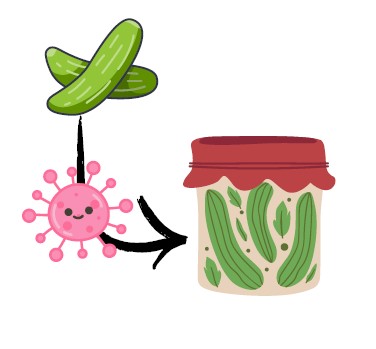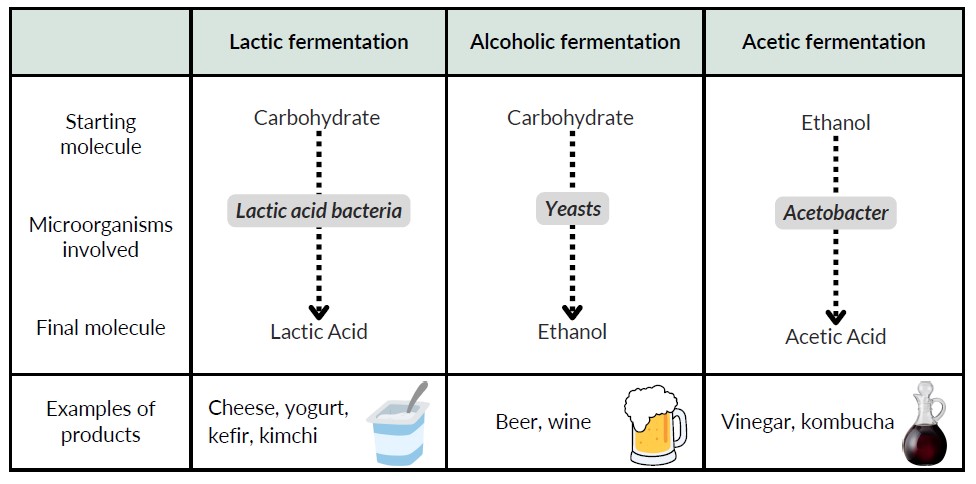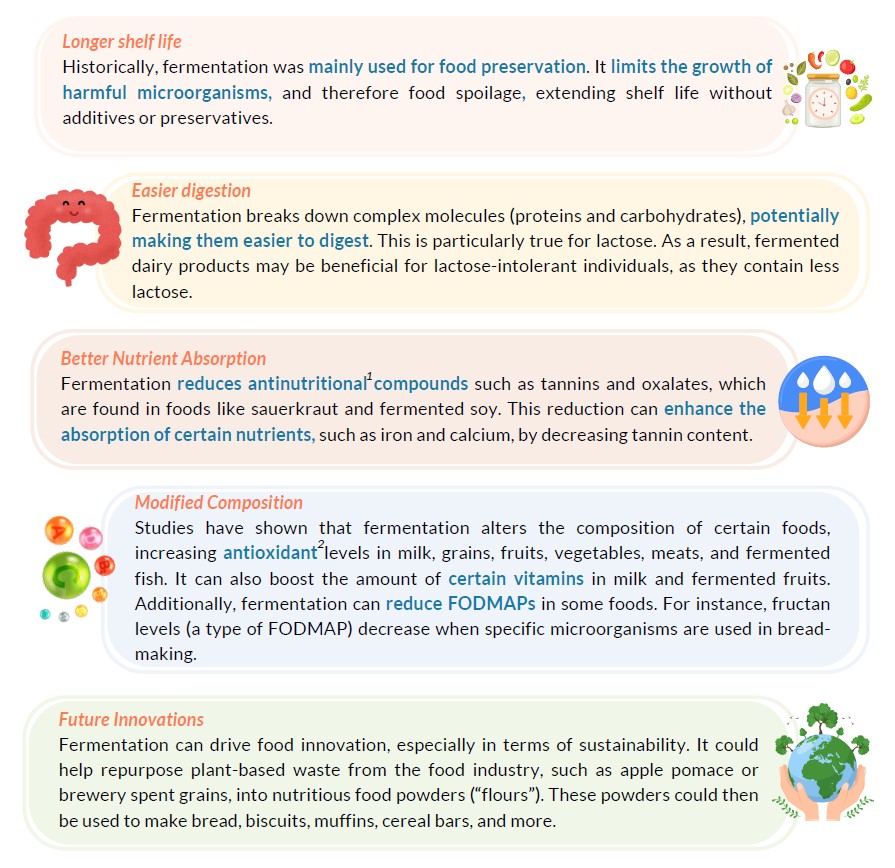Do fermented foods have any real benefits?
Source : Nutriactis/Rouen-Normandie hospital
Summary
- What is a Fermented Food?
- Types of Fermentation
- Advantages of Fermentation
- Impact of Fermented Foods on Gut Microbiota
- How to Make Fermented Vegetables Yourself?
- Conclusion
Fermented foods have been consumed for thousands of years and are present in many traditional cuisines around the world.
Recently, they have been making a comeback. Why? Homemade, longer shelf life, health benefits?
But what is the reality? In this newsletter, discover fermented foods and their link to gut microbiota.
On the last page, you’ll find a recipe to make your own fermented vegetables.
When we think of fermented foods, the first that come to mind are often kefir, kombucha, or kimchi.
But it turns out that many of the foods we eat on a more regular basis are also the result of fermentation, such as cheese, yogurt, various breads, and some cured meats.
Examples of fermented foods by country of origin

What is a Fermented Food?
A fermented food is the result of the transformation of a foodstuff through the voluntary growth of non-pathogenic* microorganisms. These microorganisms can be added intentionally (e.g. lactic ferments for cheese) or develop naturally (e.g. using salt for sauerkraut). All foods can be fermented, some more easily than others!
*microorganisms that do not cause disease in humans

Types of Fermentation
There are several types of fermentation. The most commonly used in food production are lactic, alcoholic, and acetic fermentation (as shown in the table below). However, other types also exist, such as propionic, malolactic, and butyric fermentation. The type of fermentation depends on the microorganisms and foods involved.

Did you know ? There are as many fermented products as there are possible combinations of raw materials, microorganisms, and production methods. And yes, the way a fermented food is prepared also plays a role: temperature, fermentation time, acidity, salinity, etc. This explains why, from the combination of milk and lactic bacteria, a wide variety of fermented dairy products can be created!
Advantages of Fermentation

*1: Substances present in certain foods that reduce or inhibit the absorption of essential nutrients. *2: Compounds that are poorly absorbed by the small intestine.
Proven Effects on Chronic Diseases?
Be cautious of exaggerated claims about the health benefits of fermented foods, as the topic is complex. While numerous scientific studies exist, their results are often contradictory, making it difficult to draw clear conclusions about the potential health effects of fermented foods.
Each fermented product has its own unique properties and effects. It is essential not to generalize the benefits of one fermented product to all others.
Impact of Fermented Foods on Gut Microbiota

- The Microbiota: refers to the collection of microorganisms living in a specific environment. There are different types of microbiota: intestinal, skin, oral, pulmonary, and vaginal. In the context of fermented foods, we will focus solely on the gut microbiota.
- Impact of fermented foods on gut microbiota: Although further studies need to be conducted and no consensus has been reached yet, some scientific studies suggest that fermented foods could influence the gut microbiota.
This effect could manifest in different ways:
- Prebiotic properties: Fermented foods might provide nutrients that promote or inhibit the growth and activity of certain bacteria in the gut microbiota. For example: The fermentation of certain vegetables could increase the bioavailability (the amount of nutrient actually absorbed and used by the body) of polyphenols, leading to changes in the microbiota. Some fermented foods are high in short-chain fatty acids, which play a key role in the gut microbiota bacteria and have beneficial effects on health. Vinegar, for instance, contains high levels of acetate (a short-chain fatty acid).
- Probiotic properties: The microorganisms present in fermented foods could colonize the gut and/or interact with other microorganisms, thus inducing a change in the microbiota.
Some Key Considerations
It is entirely possible to carry out artisanal fermentation of food products. However, particular attention must be paid to the higher microbiological risks, as artisanal fermentation is less controlled than industrial fermentation. There is a potential risk of contamination by pathogenic bacteria or the production of harmful molecules for health (such as mycotoxins, ethyl carbamate, and biogenic amines). To prevent this, proper cleaning of equipment is essential.
Additionally, the presence of certain compounds in fermented foods makes it necessary to limit their consumption. This is the case with salt (see Salt Newsletter), which is added in large quantities during vegetable fermentation (ranging from 2% to 10% salt), as well as alcohol, which is produced during alcoholic fermentation.
How to Make Fermented Vegetables Yourself?
Ingredients and Utensils
- The vegetables of your choice, such as: carrot, cauliflower, cabbage, radish
- 2% non-iodized salt (e.g., for a 100 mL jar, use 2g of salt)
- A jar with an airtight lid suitable for the amount of vegetables used

Preparation
- Washing: Make sure to thoroughly wash the jars, lids, utensils, and vegetables you will be using.
- Preparing the vegetables: Cut the vegetables into large, uniform pieces.
- Preparing the brine: Add the salt to the water and stir until fully dissolved.
- Jar preparation: Place your vegetables in the jar. Pour the brine over them until they are fully covered, leaving 1-2 cm of air space at the top of the jar.
- Fermentation: Store the jar at room temperature for at least 7-10 days. Afterward, you can taste the vegetables. Once the fermentation result satisfies you, place the jar in the refrigerator. Consume the vegetables within the next 2-3 months.
Explication
- It is even more important to ensure the cleanliness of the equipment to prevent undesirable contamination during the fermentation process.
- The larger the pieces, the less exposed they are to the brine, which slows down fermentation. So, large pieces for more crunch, small pieces for faster results!
- The salt (and thus the brine) encourages the growth of desirable bacteria and inhibits harmful ones. It also helps maintain the crunchy texture by slightly dehydrating the vegetables.
- The vegetables must be fully submerged for the brine to be effective. Leave a bit of air space to allow the gases produced during fermentation to escape and avoid excessive pressure inside the jar.
- Let the vegetables ferment fully first, then place the jar in the refrigerator to slow down fermentation and preserve the desired result for longer.
It is possible to ferment other vegetables, but this will change:
- The amount of salt used: More salt is required to ferment vegetables with higher water content.
- The size of the pieces to ferment: Smaller pieces are needed for vegetables that are richer in water.
- The fermentation method (brine or dry salting): Dry salting (without water) for finely cut and/or very watery vegetables, brine (water + salt) for the opposite.
As fermented vegetables contain a significant amount of salt, it is important to consume them in moderation.
Conclusion
According to recent studies, fermented foods may offer certain health benefits, although some data remain contradictory and no consensus has yet been reached. Further clinical studies are therefore essential to clarify these effects.
-
Do fermented foods have any real benefits?
pdf – 5 MB
 You might be interested in these articles
You might be interested in these articles